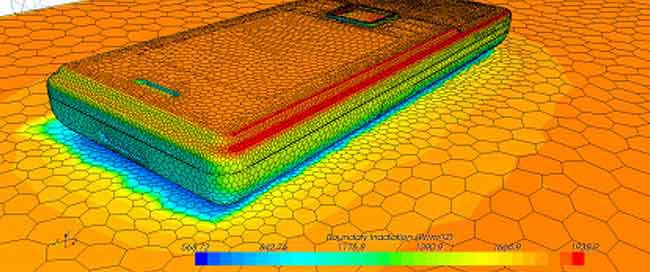Electronic Component Cooling using Computational Fluid Dynamics
Posted by: Mehul Patel | Posted on: October 15th, 2013
With the ever-increasing demands of consumers we are seeing lots of sophisticated electronic products being sold in the market now. The size of the products has also become quite small due to the sophisticated usage of components in the products. Engineers now have a new challenge of not only meeting the ever-increasing demands of customers but also use components that do not heat quickly. The basic challenge is to make the performance better in a smaller package that means this type of speculative prototyping is no longer effective.

Over-reliance on intuition and trial-and-error prototyping to predict the cooling of complex electronic systems is a certain guarantee for bad results and failure. This ultimately affects the products by decreasing the profit margins, delaying product time to market, and increasing product and repair cost. Do not rely only on physical testing as it can limit your innovations in terms of product up gradation. Temperature is also one of the crucial factors due to which there is a limiting factor in electronic devices and as devices move to higher power density, the higher temperatures reduce component efficiency and product life.
With so much of competition in electronic components happening in the market it becomes quite difficult to gauge the product performance in the early stages of design process. This is where CFD plays a crucial role. We take the numerical simulation that can provide useful insight into product performance early in the design process. It is very important to control the temperature in the inner components of the electronic device as it heats up quite quickly and if that happens, the efficiency of the component reduces thereby minimizing the product life of the electronic device. The most important thing to do in such a situation is to place sophisticated and intelligent cooling mechanisms inside the electronic device so that early detection of heating zones inside the device can be found and thus be cooled in early stages with the help of innovative technologies.
With the help of CFD simulation it is possible for an engineer to pinpoint hot spots and follow air across a board. The analysis predicts temperature at each and every point, including points that are physically impossible to measure.
An overlay of temperature and airflow graphics enables the engineers to detect interactions between the two. Moreover; there are different parameters such as heat flux vector and its components, pressure, turbulence, and intensity can be calculated and displayed.
As soon as an engineer finds a thermal problem he can quickly modify the design, reposition components, change fans, replace heat sinks, thermal pads, or add vent, and then recalculate the results. There is no need for prototyping. There were times when engineer believes that he intuitively knows how cooling air might flow or where the hot spots will crop up, only to encounter unexpected currents, fans, and vents that are poorly located, or heat sinks that are undersized. With the help of CFD analysis, engineers can eliminate the guesswork and predict results up to 10% more accurate or better.
The CFD modeling process starts with creation of 3-D solid model of the design, and specify the solution domain and ambient conditions. The next step is to specify component properties such as thermal conductivity, power dissipation, or a fan curve.
Once 3D CAD model has been constructed, it further divided into a adjoining set of grid cells. Typically, fine-grid cells produce more-accurate solutions, but take longer to calculate than coarse-grid cells.
For fast results, the engineer may choose abrasive grids when comparing early design scenarios, and then switch to fine grids for the final design stage for better accuracy. Fine grids also should be used where a solution is anticipated to change quickly, such as near inlets and outlets and around certain components.
Some of the application areas, where we can help using our CFD knowledge:
- LED
- SMPS
- CPU
- Rack server
- Heat Pipe
- Stacked Die Chips
- Electronic Chip
With the help of CFD; we can provide no-compromise simulation solution for electronics industry that can:
- Handle intricate geometries without generalization
- Resolve problems covering multiple length scales
- Solve problems including natural convection & radiation
- Allow simulation of problems involving liquids and glasses and other advanced physics
May be you like to read more about : Everything You Wanted to Know about Chemical Reactor Engineering and CFD
(Image source: cd-adapco.com)

About Author: Mehul Patel specializes in handling CFD projects for Automobile, Aerospace, Oil and Gas and building HVAC sectors. He works as a CFD consultant with Hi-Tech CFD for the past 5 years and has successfully executed numerous CFD projects of high complexities. He is an expert in turbo-machinery, gas dynamics, Combustion, Fluid Dynamics, multiphase flow analysis, computational fluid dynamics etc.
